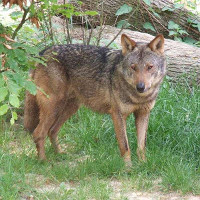 |
Iberian wolf |
|
He is a wild animal |
Origin |
Spain and Portugal | |
Translation |
Francis Vandersteen |
| The possession of this animal is not authorized Royal Decree establishing the list of mammals not kept for production purposes that may be kept (M.B. 24.08.2009) |
| The Canis lupus signatus subspecies of gray wolf was identified by Spanish zoologist Angelus Cabrera in 1907. Although many taxonomists do not recognize it, genetic work by UCLA biologist Robert Wayne suggests that it is a true subspecies. The Iberian wolf inhabits the forests and plains of northwestern Spain, northeastern Portugal, and a few isolated areas in Spain's Sierra Morena. Over 50% of Iberian wolves live in northern Castilla y Len. Iberian wolves are medium-sized, with a slimmer structure than the average Eurasian wolf. Males can weigh up to 41 kg, and females are generally 75 to 80 percent the size of males. They measure between 1.30 and 1.80 m in length, while females are 1.30 to 1.60 m long. Their coats vary in color from a lighter gray or ochre in the warmer months to a darker reddish brown in winter. The name signatus (meaning marked) was derived from the white markings on the wolf's upper lips, and the dark markings on its tail and front paws. The diet of the Iberian wolf will vary considerably depending on its exact location. Cantabrian wolves may feed on deer, roe deer and wild boar, while Galician wolves feed partly on the remains of poultry and pig farms. Castilla y Len wolves feed largely on rabbits. On the whole, their main source of nourishment is livestock. Much of this livestock used to be carrion. However, since the ban on leaving dead animals in the field due to fears of mad cow disease, wolves have turned to killing more sheep and cows. Like most other gray wolves, Iberian wolves only breed to the alpha male and female to maintain pack strength. Female wolves can usually start breeding at one year of age, but do not reach maturity until they are 5. The breeding season is at the end of winter. The brood usually consists of 5 or 6 puppies, who are cared for by the whole pack until autumn, when they join the others. They must be protected from owls and golden eagles for the first few weeks. The Iberian wolf once inhabited the vast majority of the Iberian peninsula. However, throughout the 1950s and 1960s, wolves in Spain were officially recognized as pests by the Spanish government, which offered a bounty for dead wolves. The number of wolves then fell to around 400-500, and they were classified as endangered. Wolf hunting has since been banned in Portugal and many parts of Spain. Their numbers have been estimated at around 2,000 in Spain and a further 400 in Portugal. Their general status has changed from threatened to vulnerable. However, Sierra Morena wolves are classified as critically endangered, and Extremaduran populations are thought to be extinct. Over the years, wolves have become very wary of people, so actual sightings of wolves in the wild are rare. |






 English (United Kingdom)
English (United Kingdom)